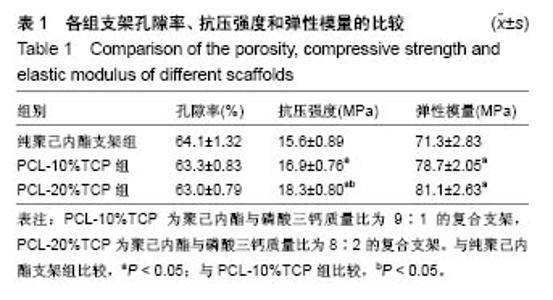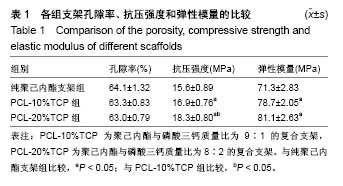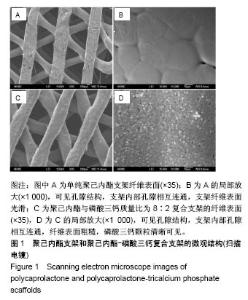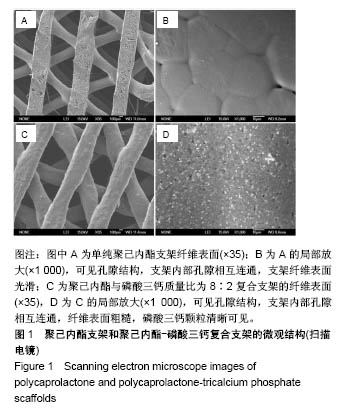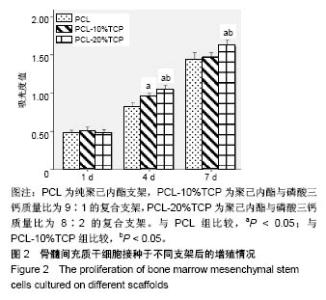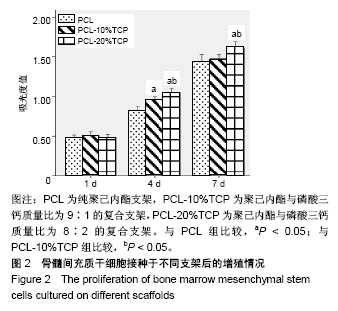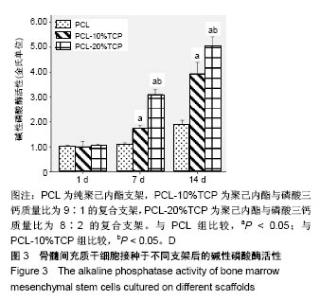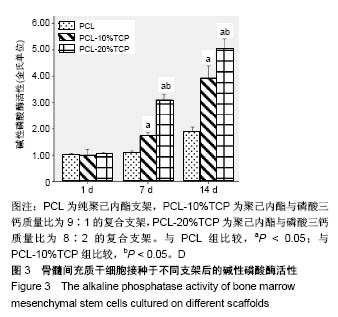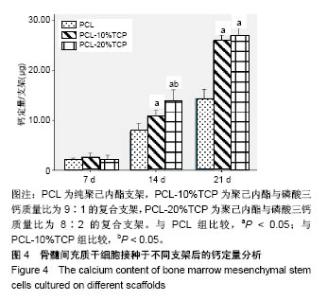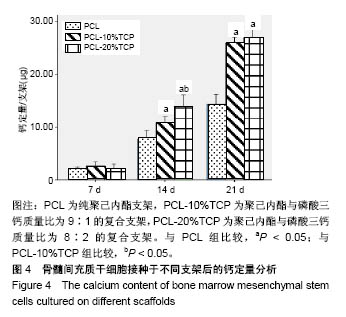Chinese Journal of Tissue Engineering Research ›› 2019, Vol. 23 ›› Issue (6): 821-826.doi: 10.3969/j.issn.2095-4344.1578
Construction of polycaprolactone-tricalcium phosphate with different mixture ratios using three-dimensional printing technology and its osteoinductivity in vitro
Yuan Bo, Wang Zhiwei, Tang Yifan, Zhou Shengyuan, Chen Xiongsheng, Jia Lianshun
- Spine Center, Department of Orthopedics, Shanghai Changzheng Hospital, Second Military Medical University, Shanghai 200003, China
-
Received:2018-10-19Online:2019-02-28Published:2019-02-28 -
Contact:Chen Xiongsheng, MD, PhD, Chief physician, Professor, Doctoral supervisor, Spine Center, Department of Orthopedics, Shanghai Changzheng Hospital, Second Military Medical University, Shanghai 200003, China -
About author:Yuan Bo, Doctorate candidate, Spine Center, Department of Orthopedics, Shanghai Changzheng Hospital, Second Military Medical University, Shanghai 200003, China -
Supported by:the Major Project of the Science and Technology Commission of Shanghai Municipality, No. 15JC1491003 (to CXS)
CLC Number:
Cite this article
Yuan Bo, Wang Zhiwei, Tang Yifan, Zhou Shengyuan, Chen Xiongsheng, Jia Lianshun. Construction of polycaprolactone-tricalcium phosphate with different mixture ratios using three-dimensional printing technology and its osteoinductivity in vitro[J]. Chinese Journal of Tissue Engineering Research, 2019, 23(6): 821-826.
share this article
Add to citation manager EndNote|Reference Manager|ProCite|BibTeX|RefWorks
| [1] Oryan A, Alidadi S, Moshiri A, et al. Bone regenerative medicine: classic options, novel strategies, and future directions.2014:9,18.[2] Campana V, Milano G, Pagano E, et al. Bone substitutes in orthopaedic surgery: from basic science to clinical practice. J Mater Sci Mater Med.2014;25(10):2445-2461.[3] Polo-Corrales L, Latorre-Esteves M, Ramirez-Vick J E. Scaffold design for bone regeneration. J Nanosci Nanotechnol. 2014; 14(1): 15-56.[4] Giannoudis PV, Chris Arts JJ,Schmidmaier G,et al. What should be the characteristics of the ideal bone graft substitute? Injury. 2011; 42:S1-S2.[5] Lee JW, Kim JY, Cho DW. Solid Free-form Fabrication Technology and Its Application to Bone Tissue Engineering.Int J Stem Cells. 2010;3(2): 85-95.[6] Tabata Y. Biomaterial technology for tissue engineering applications. J R Soc Interface.2009;6 Suppl 3:S311-S324.[7] Hutmacher DW.Scaffold design and fabrication technologies for engineering tissues--state of the art and future perspectives.J Biomater Sci Polym Ed.2001;12(1):107-124.[8] Lee J, Choi B, Wu B, et al. Customized biomimetic scaffolds created by indirect three-dimensional printing for tissue engineering. Biofabrication.2013;5(4):45003.[9] Frame M, Huntley JS. Rapid Prototyping in Orthopaedic Surgery: A User's Guide. ScientificWorldJournal. 2012;2012:1-7.[10] Li Y,Wu Z,Li X,et al.A polycaprolactone-tricalcium phosphate composite scaffold as an autograft-free spinal fusion cage in a sheep model.Biomaterials.2014;35(22):5647-5659.[11] Rai B,Lin JL,Lim ZX, et al. Differences between in vitro viability and differentiation and in vivo bone-forming efficacy of human mesenchymal stem cells cultured on PCL–TCP scaffolds. Biomaterials. 2010;31(31):7960-7970.[12] Pati F,Song TH, Rijal G,et al.Ornamenting 3D printed scaffolds with cell-laid extracellular matrix for bone tissue regeneration. Biomaterials. 2015;37:230-241.[13] Ba LN,Min YK,Lee BT.Hybrid hydroxyapatite nanoparticles-loaded PCL/GE blend fibers for bone tissue engineering. 2013:24, 520-538.[14] Becker J,Lu L,Runge MB,et al.Nanocomposite bone scaffolds based on biodegradable polymers and hydroxyapatite.J Biomed Mater Res A. 2015;103(8):2549-2557.[15] Thadavirul N,Pavasant P,Supaphol P.Improvement of dual-leached polycaprolactone porous scaffolds by incorporating with hydroxyapatite for bone tissue regeneration.J Biomater Sci Polym Ed. 2014;25(17):1986-2008.[16] Lohfeld S,Cahill S,Barron V,et al.Fabrication, mechanical and in vivo performance of polycaprolactone/tricalcium phosphate composite scaffolds.Acta Biomater. 2012;8(9): 3446-3456.[17] Yeo A,Cheok C,Teoh SH,et al.Lateral ridge augmentation using a PCL-TCP scaffold in a clinically relevant but challenging micropig model.Clin Oral Implants Res. 2012; 23(12):1322-1332.[18] Khojasteh A,Behnia H,Hosseini FS,et al.The effect of PCL-TCP scaffold loaded with mesenchymal stem cells on vertical bone augmentation in dog mandible: a preliminary report.J Biomed Mater Res B Appl Biomater. 2013;101(5): 848-854.[19] Bose S,Roy M,Bandyopadhyay A.Recent advances in bone tissue engineering scaffolds.Trends Biotechnol.2012;30(10):546-554.[20] Calori GM,Mazza E,Colombo M,et al.The use of bone-graft substitutes in large bone defects: Any specific needs? Injury. 2011;42:S56-S63.[21] Saiz E,Zimmermann EA,Lee JS,et al.Perspectives on the role of nanotechnology in bone tissue engineering.Dent Mater. 2013; 29(1):103-115.[22] Baykan E,Koc A,Eser EA,et al.Evaluation of a biomimetic poly(epsilon-caprolactone)/beta-tricalcium phosphate multispiral scaffold for bone tissue engineering: in vitro and in vivo studies. Biointerphases.2014;9(2):29011.[23] Yang K,Zhang J,Ma X,et al.β-Tricalcium phosphate/poly(glycerol sebacate) scaffolds with robust mechanical property for bone tissue engineering.Mater Sci Eng C Mater Biol Appl.2015;56:37-47.[24] Idaszek J,Bruinink A,Swieszkowski W.Ternary composite scaffolds with tailorable degradation rate and highly improved colonization by human bone marrow stromal cells.J Biomed Mater Res A. 2015; 103(7):2394-2404.[25] Sharaf B,Faris CB,Abukawa H,et al. Three-dimensionally printed polycaprolactone and β-tricalcium phosphate scaffolds for bone tissue engineering: an in vitro study.J Oral Maxillofac Surg. 2012; 70(3):647-656.[26] Doyle H,Lohfeld S,Mchugh P.Predicting the elastic properties of selective laser sintered PCL/beta-TCP bone scaffold materials using computational modelling.Ann Biomed Eng. 2014;42(3): 661-677.[27] Xu N, Ye X, Wei D, et al. 3D artificial bones for bone repair prepared by computed tomography-guided fused deposition modeling for bone repair. ACS Appl Mater Interfaces. 2014;6(17):14952-14963. [28] Shor L,Guceri S,Wen X,et al. Fabrication of three-dimensional polycaprolactone/hydroxyapatite tissue scaffolds and osteoblast-scaffold interactions in vitro. Biomaterials. 2007;28(35): 5291-5297.[29] Beguma Z,Chhedat P.Rapid prototyping--when virtual meets reality. Int J Comput Dent.2014;17(4):297-306.[30] Kim J,Mcbride S,Tellis B,et al.Rapid-prototyped PLGA/beta-TCP/ hydroxyapatite nanocomposite scaffolds in a rabbit femoral defect model. Biofabrication.2012;4(2):25003.[31] Park S, Kim G, Jeon YC, et al.3D polycaprolactone scaffolds with controlled pore structure using a rapid prototyping system.J Mater Sci Mater Med.2009;20(1):229-234.[32] Hutmacher DW.Scaffolds in tissue engineering bone and cartilage. Biomaterials.2000;21(24):2529-2543.[33] Briggs T, Matos J, Collins G, et al. Evaluating protein incorporation and release in electrospun composite scaffolds for bone tissue engineering applications.J Biomed Mater Res A. 2015;103(10): 3117-3127. [34] Shim JH, Huh JB, Park JY, et al. Fabrication of blended polycaprolactone/poly(lactic-co-glycolic acid)/beta-tricalcium phosphate thin membrane using solid freeform fabrication technology for guided bone regeneration.Tissue Eng Part A. 2013; 19(3-4):317-328.[35] Doyle H, Lohfeld S, Mchugh P. Evaluating the effect of increasing ceramic content on the mechanical properties, material microstructure and degradation of selective laser sintered polycaprolactone/ β-tricalcium phosphate materials.Med Eng Phys. 2015;37(8):767-776.[36] Nyberg E,Rindone A,Dorafshar A,et al. Comparison of 3D-Printed Poly-?-Caprolactone Scaffolds Functionalized with Tricalcium Phosphate, Hydroxyapatite, Bio-Oss, or Decellularized Bone Matrix. Tissue Eng Part A.2017;23(11-12):503-514.[37] Park S, Lee H, Kim K, et al. In Vivo Evaluation of 3D-Printed Polycaprolactone Scaffold Implantation Combined with β-TCP Powder for Alveolar Bone Augmentation in a Beagle Defect Model. Materials, 2018,11(2):238.[38] Kim J,Ahn G,Kim C,et al.Synergistic Effects of Beta Tri-Calcium Phosphate and Porcine-Derived Decellularized Bone Extracellular Matrix in 3D-Printed Polycaprolactone Scaffold on Bone Regeneration.Macromolecular Bioscience.2018;18(6):1800025.[39] Bae J,Lee J,Shim J,et al.Development and Assessment of a 3D-Printed Scaffold with rhBMP-2 for an Implant Surgical Guide Stent and Bone Graft Material: A Pilot Animal Study. Materials (Basel). 2017;10(12):1434.[40] Konopnicki S,Sharaf B,Resnick C,et al. Tissue-engineered bone with 3-dimensionally printed β-tricalcium phosphate and polycaprolactone scaffolds and early implantation: an in vivo pilot study in a porcine mandible model.J Oral Maxillofac Surg. 2015; 73(5):1011-1016.[41] Yao Q,Cosme JG, Xu T,et al.Three dimensional electrospun PCL/PLA blend nanofibrous scaffolds with significantly improved stem cells osteogenic differentiation and cranial bone formation. Biomaterials. 2017;115:115-127. |
| [1] | Pu Rui, Chen Ziyang, Yuan Lingyan. Characteristics and effects of exosomes from different cell sources in cardioprotection [J]. Chinese Journal of Tissue Engineering Research, 2021, 25(在线): 1-. |
| [2] | Lin Qingfan, Xie Yixin, Chen Wanqing, Ye Zhenzhong, Chen Youfang. Human placenta-derived mesenchymal stem cell conditioned medium can upregulate BeWo cell viability and zonula occludens expression under hypoxia [J]. Chinese Journal of Tissue Engineering Research, 2021, 25(在线): 4970-4975. |
| [3] | Zhang Tongtong, Wang Zhonghua, Wen Jie, Song Yuxin, Liu Lin. Application of three-dimensional printing model in surgical resection and reconstruction of cervical tumor [J]. Chinese Journal of Tissue Engineering Research, 2021, 25(9): 1335-1339. |
| [4] | Hou Jingying, Yu Menglei, Guo Tianzhu, Long Huibao, Wu Hao. Hypoxia preconditioning promotes bone marrow mesenchymal stem cells survival and vascularization through the activation of HIF-1α/MALAT1/VEGFA pathway [J]. Chinese Journal of Tissue Engineering Research, 2021, 25(7): 985-990. |
| [5] | Shi Yangyang, Qin Yingfei, Wu Fuling, He Xiao, Zhang Xuejing. Pretreatment of placental mesenchymal stem cells to prevent bronchiolitis in mice [J]. Chinese Journal of Tissue Engineering Research, 2021, 25(7): 991-995. |
| [6] | Liang Xueqi, Guo Lijiao, Chen Hejie, Wu Jie, Sun Yaqi, Xing Zhikun, Zou Hailiang, Chen Xueling, Wu Xiangwei. Alveolar echinococcosis protoscolices inhibits the differentiation of bone marrow mesenchymal stem cells into fibroblasts [J]. Chinese Journal of Tissue Engineering Research, 2021, 25(7): 996-1001. |
| [7] | Fan Quanbao, Luo Huina, Wang Bingyun, Chen Shengfeng, Cui Lianxu, Jiang Wenkang, Zhao Mingming, Wang Jingjing, Luo Dongzhang, Chen Zhisheng, Bai Yinshan, Liu Canying, Zhang Hui. Biological characteristics of canine adipose-derived mesenchymal stem cells cultured in hypoxia [J]. Chinese Journal of Tissue Engineering Research, 2021, 25(7): 1002-1007. |
| [8] | Geng Yao, Yin Zhiliang, Li Xingping, Xiao Dongqin, Hou Weiguang. Role of hsa-miRNA-223-3p in regulating osteogenic differentiation of human bone marrow mesenchymal stem cells [J]. Chinese Journal of Tissue Engineering Research, 2021, 25(7): 1008-1013. |
| [9] | Lun Zhigang, Jin Jing, Wang Tianyan, Li Aimin. Effect of peroxiredoxin 6 on proliferation and differentiation of bone marrow mesenchymal stem cells into neural lineage in vitro [J]. Chinese Journal of Tissue Engineering Research, 2021, 25(7): 1014-1018. |
| [10] | Zhu Xuefen, Huang Cheng, Ding Jian, Dai Yongping, Liu Yuanbing, Le Lixiang, Wang Liangliang, Yang Jiandong. Mechanism of bone marrow mesenchymal stem cells differentiation into functional neurons induced by glial cell line derived neurotrophic factor [J]. Chinese Journal of Tissue Engineering Research, 2021, 25(7): 1019-1025. |
| [11] | Duan Liyun, Cao Xiaocang. Human placenta mesenchymal stem cells-derived extracellular vesicles regulate collagen deposition in intestinal mucosa of mice with colitis [J]. Chinese Journal of Tissue Engineering Research, 2021, 25(7): 1026-1031. |
| [12] | Pei Lili, Sun Guicai, Wang Di. Salvianolic acid B inhibits oxidative damage of bone marrow mesenchymal stem cells and promotes differentiation into cardiomyocytes [J]. Chinese Journal of Tissue Engineering Research, 2021, 25(7): 1032-1036. |
| [13] | Wang Xianyao, Guan Yalin, Liu Zhongshan. Strategies for improving the therapeutic efficacy of mesenchymal stem cells in the treatment of nonhealing wounds [J]. Chinese Journal of Tissue Engineering Research, 2021, 25(7): 1081-1087. |
| [14] | Wang Shiqi, Zhang Jinsheng. Effects of Chinese medicine on proliferation, differentiation and aging of bone marrow mesenchymal stem cells regulating ischemia-hypoxia microenvironment [J]. Chinese Journal of Tissue Engineering Research, 2021, 25(7): 1129-1134. |
| [15] | Zeng Yanhua, Hao Yanlei. In vitro culture and purification of Schwann cells: a systematic review [J]. Chinese Journal of Tissue Engineering Research, 2021, 25(7): 1135-1141. |
| Viewed | ||||||
|
Full text |
|
|||||
|
Abstract |
|
|||||
